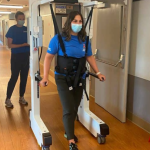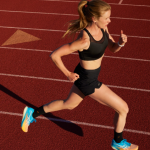In our previous post about gait retraining, we discussed how adjusting your cadence can help improve your landing position, reduce lower extremity stress, and enhance muscle activation. Now, let’s focus on another often-overlooked element of running form: your arm swing.
For many runners, arm swing is something that happens without much thought. However, it plays a critical role in maintaining balance and stabilizing your body as you run, helping you move forward in a straight line. The way your head, neck, and shoulders align also impacts your posture and arm movement. Improving these elements can significantly boost your overall running efficiency and performance.
The Role of Arm Swing in Running Mechanics
Studies suggest that arm swing in running is largely a passive action driven by the thorax. The arm motion provides a counterbalance to the rotational and angular movement of the legs during the swing phase of running. This thoracic motion is a combination of active engagement through the external obliques in your abdomen and passive movement driven by the pelvis and lower body mechanics, creating a connected system. By adjusting your arm swing, you can effectively modify your gait to improve your overall running mechanics.
How to Tell if Your Arm Swing Needs Adjustment
To assess whether your arm swing needs work, take a moment to check yourself:
- Look down at your arms while running. Are they moving, or are you mainly rotating through your torso?
- Are your arms swinging out to the side, or are they staying relatively still?
- Check yourself in a reflection—do your arms move forward and backward across your body, or do they remain static?
Another way to assess your form is to have someone film or take a picture of you while running, allowing you to analyze your arm movement during each phase of your gait.
How Should Your Arms Swing?
Your arms should mirror the movement of your legs, swinging forward and backward. One cue I often give runners is to imagine their hands moving from their “heart to pocket” as they run. Another tip is to focus on having your elbow gently brush your side as your arm moves backward. Ideally, you should feel the motion in both your arms and shoulders as they move with each stride.
Potential Issues with Inefficient Arm Swing
Here are some problems that can arise from poor arm swing mechanics:
- Limited Hip Extension: Poor posture and tight, rounded shoulders can limit your hip extension. If your arms stay close to your body or your posture is too rounded, you may compensate by leaning more from your hips. This could lead to inefficient core engagement, shallow breathing, and tightness in the hip flexors.
- Increased Rotational Forces in the Lower Back: If your arm swing is inefficient, it can lead to excessive rotation in the thoracolumbar (TL) junction, causing tightness in your lower back.
- Hip Adduction and Knee Rotation: Over-rotation through the thorax can result in your stance leg being positioned in relative internal rotation and adduction. This misalignment increases the risk of knee and lower limb injuries.
- Decreased Running Efficiency: If your arms are not swinging properly or if you’re losing balance, you’ll waste energy and momentum, leading to reduced efficiency in your run.
Tips for Improving Arm Swing
Here are some effective ways to refine your arm swing:
- Improve Thoracic Spine Mobility: Increasing mobility in your thoracic spine is key. Incorporate exercises like shoulder circles and reach and roll stretches to increase flexibility in this area.
- Stretch Your Lats and Pectorals: Tightness in your latissimus dorsi or pectoral muscles can affect your arm swing. Use a foam roller to stretch these areas regularly.
- Focus on Posture: Maintain a tall posture while running. Keep your rib cage aligned over your pelvis and focus on breathing deeply to engage your core properly.
- Practice Arm Swing Drills: A simple but effective drill is to practice the motion of arm swinging without running. This helps you internalize the proper arm movement and feel what it should be like while running.
Final Thoughts
When making adjustments to your running form, remember to make gradual changes. I recommend focusing on one change at a time and sticking with it for three to four weeks before adding another modification. Your body will need time to adapt, and it’s normal to feel more fatigued initially, even if you’re experiencing improved efficiency and less pain.
If you have any questions about refining your arm swing or encounter difficulties with the process, feel free to reach out for assistance!





